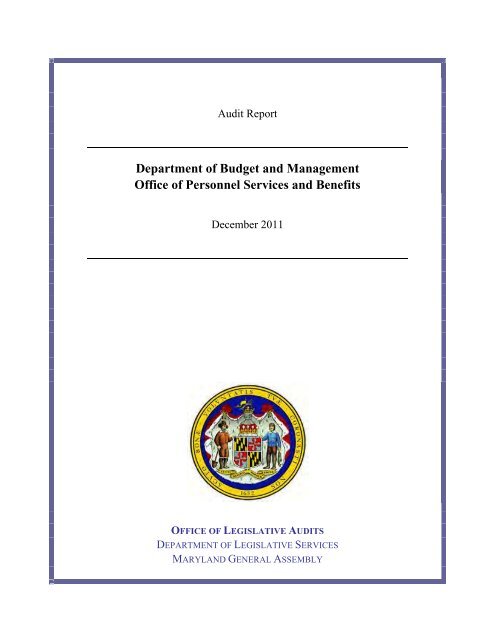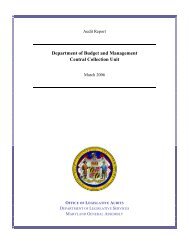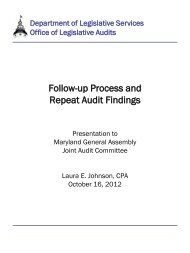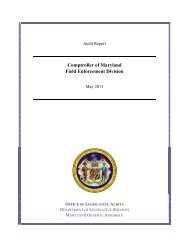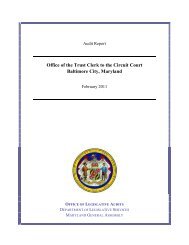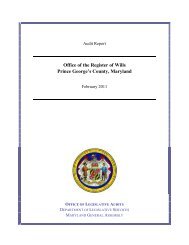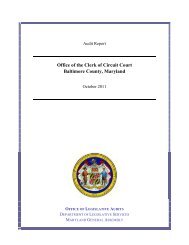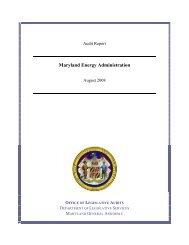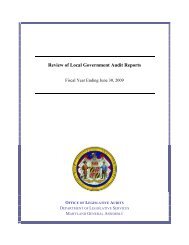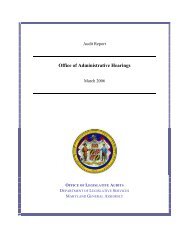Department of Budget and Management - Office of Legislative Audits
Department of Budget and Management - Office of Legislative Audits
Department of Budget and Management - Office of Legislative Audits
You also want an ePaper? Increase the reach of your titles
YUMPU automatically turns print PDFs into web optimized ePapers that Google loves.
Audit Report<strong>Department</strong> <strong>of</strong> <strong>Budget</strong> <strong>and</strong> <strong>Management</strong><strong>Office</strong> <strong>of</strong> Personnel Services <strong>and</strong> BenefitsDecember 2011OFFICE OF LEGISLATIVE AUDITSDEPARTMENT OF LEGISLATIVE SERVICESMARYLAND GENERAL ASSEMBLY
This report <strong>and</strong> any related follow-up correspondence are available to the public through the<strong>Office</strong> <strong>of</strong> <strong>Legislative</strong> <strong>Audits</strong> at 301 West Preston Street, Room 1202, Baltimore, Maryl<strong>and</strong>21201. The <strong>Office</strong> may be contacted by telephone at 410-946-5900, 301-970-5900, or 1-877-486-9964.Electronic copies <strong>of</strong> our audit reports can be viewed or downloaded from our website athttp://www.ola.state.md.us. Alternate formats may be requested through the Maryl<strong>and</strong> Relay Service at 1-800-735-2258.The <strong>Department</strong> <strong>of</strong> <strong>Legislative</strong> Services – <strong>Office</strong> <strong>of</strong> the Executive Director, 90 State Circle,Annapolis, Maryl<strong>and</strong> 21401 can also assist you in obtaining copies <strong>of</strong> our reports <strong>and</strong> relatedcorrespondence. The <strong>Department</strong> may be contacted by telephone at 410-946-5400 or 301-970-5400.
Table <strong>of</strong> ContentsExecutive Summary 5Background Information 7Agency Responsibilities 7Health Benefits Administration 7Status <strong>of</strong> Findings From Preceding Audit Report 8Findings <strong>and</strong> Recommendations 9Special Bank AccountsFinding 1 – OPSB Requested Reimbursements in Excess <strong>of</strong> Amounts 9Paid to Healthcare Administrators Resulting in an Accumulation <strong>of</strong>Funds in its Special Bank AccountsPersonnel Transaction SystemFinding 2 (Policy Issue) – Uniform Policies Governing Employee 10Termination From State Service Were Not EstablishedInformation Systems Security <strong>and</strong> Control* Finding 3 – Personally Identifiable Information Was Not Properly 13Secured* Finding 4 – The Benefits Administration System Database Was Not 13Adequately MonitoredFinding 5 – OPSB Had Not Established Sufficient Internal Controls 14Over Insurance Eligibility Records <strong>and</strong> Premium Payment RecordsHealth Insurance Administrative FeeFinding 6 – An Independent Review Was Not Performed <strong>of</strong> OPSB’s 15Calculation <strong>of</strong> Administrative Fee Payments<strong>Audits</strong> <strong>of</strong> Health Plan AdministratorsFinding 7 – OPSB Did Not Adequately Monitor Certain Contracts 16for <strong>Audits</strong> <strong>of</strong> Health Plan AdministratorsCash ReceiptsFinding 8 – OPSB Had Not Sufficiently Controlled Cash Receipts 17* Denotes item repeated in full or part from preceding audit report3
Audit Scope, Objectives, <strong>and</strong> Methodology 19Agency ResponseAppendix4
Executive Summary<strong>Legislative</strong> Audit Report on <strong>Department</strong> <strong>of</strong> <strong>Budget</strong> <strong>and</strong> <strong>Management</strong><strong>Office</strong> <strong>of</strong> Personnel Services <strong>and</strong> Benefits (OPSB)December 2011OPSB requested reimbursements that exceeded the related healthcareexpenditures paid resulting in an accumulation <strong>of</strong> funds in its specialbank accounts which exceeded the $2.5 million advance authorized by theComptroller <strong>of</strong> Maryl<strong>and</strong> by $18.9 million.OPSB should periodically review the sufficiency <strong>of</strong> its advances, return anyexcess balances held, <strong>and</strong> seek approval <strong>of</strong> the Comptroller <strong>of</strong> Maryl<strong>and</strong> foradditional advances so that, in the future, reimbursement requests can belimited to actual payments made.Uniform policies were not established governing termination <strong>of</strong>employees from State service, <strong>and</strong> certain termination information wasnot being shared. As a result, we noted certain employees who weredisqualified from future employment by the Maryl<strong>and</strong> <strong>Department</strong> <strong>of</strong>Transportation that were subsequently hired by other State agencies.OPSB, in conjunction with other State agencies that are not in the StatePersonnel <strong>Management</strong> System, should attempt to develop uniform policiesthat govern employees terminated with prejudice from all State agencies.OPSB should also create a comprehensive list <strong>of</strong> employees terminated withprejudice from all State agencies <strong>and</strong> make the list accessible to all Stateagencies for use in future hiring decisions.Deficiencies in monitoring healthcare administrative fees <strong>and</strong> the audits<strong>of</strong> health plan administrators were noted. Sufficient internal controlsover information system security <strong>and</strong> cash receipts were not established.OPSB should improve its monitoring <strong>of</strong> programs <strong>and</strong> internal controls asrecommended.5
Agency ResponsibilitiesBackground InformationThe <strong>Department</strong> <strong>of</strong> <strong>Budget</strong> <strong>and</strong> <strong>Management</strong> – <strong>Office</strong> <strong>of</strong> Personnel Services <strong>and</strong>Benefits (OPSB) directs the development <strong>of</strong> State personnel policies. 1 OPSB alsoadministers the health care benefit programs for State employees <strong>and</strong> retirees aswell as the flexible spending accounts for State employees. OPSB is alsoresponsible for a variety <strong>of</strong> other programs, including salary administration <strong>and</strong>classification, recruitment <strong>and</strong> examination, <strong>and</strong> employee relations.Health Benefits AdministrationThe State obtains health care coverage for its employees <strong>and</strong> retirees (includingtheir spouses, same-sex domestic partners, <strong>and</strong> dependents) through three majorhealth insurance providers, which administer preferred provider organization(PPO), point-<strong>of</strong>-service (POS), <strong>and</strong> exclusive provider organization (EPO) plans.The State discontinued providing coverage through health maintenanceorganizations effective July 1, 2009, except for dental insurance. Dentalinsurance is provided through two plans <strong>of</strong>fered by one provider. The currentcontracts with the health <strong>and</strong> dental plan providers cover the period from July 1,2009 to June 30, 2014.The State also provides prescription drug <strong>and</strong> mental health benefits through twoother administrators. The current contract for prescription drugs became effectiveon April 4, 2007 <strong>and</strong>, including renewals, continues through June 30, 2012. Thecurrent mental health contract covers the period from April 1, 2011 to June 30,2014. Employees <strong>and</strong> retirees enrolled in the PPO <strong>and</strong> POS plans areautomatically enrolled in the aforementioned mental health plan; the EPO plansinclude mental health services.The State directly pays claims for the PPO, POS, EPO, prescription drug, <strong>and</strong>mental health plans. It self-funds these plans <strong>and</strong> accepts the risk for all medicalcosts. Total health benefit payments have increased from approximately $993million for fiscal year 2008 to approximately $1.2 billion for fiscal year 2011,representing an increase <strong>of</strong> 20.6 percent. Health care enrollment <strong>and</strong> costs paid infiscal year 2011 for plan participants, which include State employees, retirees,1 OPSB’s responsibilities include those policies under the State Personnel <strong>Management</strong> System,which applies to the employees in most State agencies. Certain agencies, primarily the Maryl<strong>and</strong><strong>Department</strong> <strong>of</strong> Transportation <strong>and</strong> the University System <strong>of</strong> Maryl<strong>and</strong>, maintain their ownpersonnel systems <strong>and</strong> related policies.7
same-sex domestic partners, dependents, direct pay participants, <strong>and</strong> satelliteagency participants (such as covered employees <strong>of</strong> local governments) aresummarized in the following table.Number <strong>of</strong> Plan Participants in the State <strong>of</strong> Maryl<strong>and</strong>’s Health Benefits Program<strong>and</strong> the Related Costs for Fiscal Year 2011Plan TypeEnrollment(as <strong>of</strong> 6/30/11)Claims PaidAdministrativeExpensesTotalPaymentsPPO 64,369 $ 430,497,241 $ 22,839,211 $ 453,336,452POS 33,257 215,222,347 14,182,129 229,404,476EPO 16,256 100,711,857 6,373,743 107,085,600Prescription Drug 107,808 383,868,823 4,156,448 388,025,271Mental Health 97,626 16,906,197 2,920,150 19,826,347Totals $1,147,206,465 $ 50,471,681 $1,197,678,146Source: OPSB records (unaudited)Status <strong>of</strong> Findings From Preceding Audit ReportOur audit included a review to determine the status <strong>of</strong> the 14 findings contained inour preceding audit report dated February 19, 2009. We determined that OPSBsatisfactorily addressed 12 <strong>of</strong> these findings. The remaining 2 findings arerepeated in this report.8
Special Bank AccountsFindings <strong>and</strong> RecommendationsFinding 1Reimbursements requested by the <strong>Office</strong> <strong>of</strong> Personnel Services <strong>and</strong> Benefits(OPSB) exceeded amounts paid to healthcare plan administrators resultingin an accumulation <strong>of</strong> funds in OPSB’s special bank accounts. As <strong>of</strong>February 2011, the account balances were $18.9 million greater than theauthorized advance.AnalysisOPSB periodically requested reimbursement amounts that exceeded the paymentsactually made to the healthcare plan administrators resulting in special bankaccount balances that were greater than the working fund advance authorized bythe Comptroller <strong>of</strong> Maryl<strong>and</strong> (COM) by $18.9 million. OPSB maintains fourspecial bank accounts (one for each <strong>of</strong> the four healthcare plan administrators)that are used to pay healthcare expenditure invoices received weekly from theadministrators. Using the State’s transmittal process, OPSB subsequently submitsrequests for reimbursement, generally on a weekly basis, to COM – GeneralAccounting Division (GAD). After GAD approval, the State Treasurer’s <strong>Office</strong>(STO) transfers funds to replenish the special bank accounts.However, OPSB’s requests to GAD did not always agree with the detail invoicesreceived from the healthcare plan administrators which were also submitted toGAD; rather, the requested reimbursement amounts were based on OPSBprepared documents. Submitting reimbursement requests for amounts it cannotsubstantiate violates GAD policies.Our test <strong>of</strong> seven payments to the healthcare administrators <strong>and</strong> the relatedreimbursements received from STO during the period from July 2009 toDecember 2010 disclosed six instances in which the reimbursement amountrequested by OPSB exceeded the amount paid to the plan administrators by a total<strong>of</strong> approximately $6.9 million. According to the State’s accounting records, as <strong>of</strong>February 2011, COM had authorized a total advance <strong>of</strong> $2.5 million from theCOM for the four special bank accounts. Nevertheless, OPSB’s records as <strong>of</strong>February 2011 reflected balances (or in effect advances) totaling $21.4 million inthe special bank accounts, which was $18.9 million greater than the advanceauthorized by the COM.9
OPSB advised us that it has a contractual obligation to pay healthcare claimswithin 24 hours <strong>of</strong> receipt <strong>of</strong> the plan administrators’ invoices, <strong>and</strong> that the $2.5million total advance from the COM (which was authorized in July 2000) was notsufficient to cover the healthcare benefit payments processed each week. Thus,OPSB had requested excessive reimbursements in order to accumulate a sufficientcash balance to make the payments to the plan administrators. According to itsrecords, during fiscal year 2010, OPSB disbursed approximately $729 millionfrom these special bank accounts to healthcare plan administrators (which, onaverage, is $14 million weekly). Although the COM has established proceduresfor obtaining authorization to increase such advances, OPSB did not request anincrease. Furthermore, OPSB had not analyzed the account activity to determinethe appropriate advance amount. The COM’s Accounting Procedures Manualrequires State agencies to review advances periodically <strong>and</strong> obtain authorizationfrom the COM to increase the advances as necessary. The Manual also requiresthat reimbursement requests generally be supported by documentation <strong>of</strong> amountspaid.Recommendation 1We recommend that OPSBa. in the future, limit its reimbursement requests to the actual paymentsmade to plan administrators; <strong>and</strong>b. periodically review the sufficiency <strong>of</strong> its advances, return to the StateTreasurer any balances held in excess <strong>of</strong> the needed advances, <strong>and</strong>formally request necessary adjustments to the authorized balances asappropriate from the COM.Personnel Transaction SystemFinding 2 (Policy Issue)Policies governing the rehiring <strong>of</strong> employees terminated from State servicewere not uniform among the State’s various personnel systems, <strong>and</strong> certaintermination information was not being shared.AnalysisUniform policies that govern the rehiring <strong>of</strong> State employees terminated fromState agencies were not established, <strong>and</strong> certain termination information was notbeing shared among the State’s various personnel systems.Although State law authorizes separate personnel systems for certain State entities<strong>and</strong> authorizes those systems to develop governing regulations, we noted that the10
egulations that govern the rehiring <strong>of</strong> employees terminated with prejudice 2 fromagencies have different requirements. The regulations for the State Personnel<strong>Management</strong> System (the system for which OBSP is responsible) state thatemployees terminated with prejudice are barred from future employment in anycapacity with the State for three years. On the other h<strong>and</strong>, regulations that governemployees terminated from the Maryl<strong>and</strong> State <strong>Department</strong> <strong>of</strong> Transportation(MDOT) are authorized under the Transportation Article <strong>of</strong> the Annotated Code<strong>of</strong> Maryl<strong>and</strong>. Under MDOT regulations, terminated employees from an MDOTagency may be disqualified from future employment at all or certain <strong>of</strong> theMDOT agencies. Furthermore, each State university under the University System<strong>of</strong> Maryl<strong>and</strong> (USM) has its own termination <strong>and</strong> hiring policies. Since Stateemployees do seek other employment opportunities among agencies under thevarious personnel systems, we believe the State should assess whether thereshould be uniform policies for rehiring terminated State personnel. As the entityresponsible for administering the largest personnel system for Executive Branchagencies, we believe OPSB would be in the best position to coordinate theassessment.Furthermore, certain mechanisms were not established to share terminationinformation among the various personnel systems. A comprehensive list <strong>of</strong>employees that were terminated with prejudice from all State agencies was notmaintained. Rather, OPSB maintained the list <strong>of</strong> employees terminated withprejudice only from those State agencies in the State Personnel <strong>Management</strong>System. This list did not include employees terminated with prejudice from otherState agencies that are not part <strong>of</strong> the State Personnel <strong>Management</strong> System,including employees disqualified from future employment in MDOT or USM.Furthermore, State agencies that are not in the State Personnel <strong>Management</strong>System did not have access to the list <strong>of</strong> employees terminated with prejudicemaintained by OPSB. Consequently, employees that were terminated withprejudice from MDOT or USM could be hired by agencies in the State Personnel<strong>Management</strong> System or vice versa without detection or consideration <strong>of</strong> pastactions.Our comparison <strong>of</strong> employees terminated with prejudice from the State Personnel<strong>Management</strong> System during fiscal years 2008 to 2011 to employees hired byMDOT, USM, or the agencies under the State Personnel <strong>Management</strong> Systemduring the same period did not disclose any instances in which an employee whowas terminated with prejudice being rehired by any State agency. However, our2 Per the Annotated Code <strong>of</strong> Maryl<strong>and</strong>, an employee may be terminated with prejudice if theemployee’s actions are egregious to the extent that the employee does not merit employment inany capacity with the State.11
data match <strong>of</strong> the list <strong>of</strong> MDOT-terminated employees disqualified from futureemployment at MDOT, or a specified agency within MDOT, to the current list <strong>of</strong>State employees resulted in 61 matches. Our further test <strong>of</strong> 12 <strong>of</strong> those 61employees revealed 11 <strong>of</strong> the employees (6 disqualified from employment at anyMDOT agency <strong>and</strong> 5 disqualified from employment at a specified MDOTagency) obtained employment in other State agencies, <strong>and</strong> 8 <strong>of</strong> the employeeswere hired within three years <strong>of</strong> termination from MDOT agencies. Thetermination <strong>of</strong> the final employee (<strong>of</strong> the 12 tested) by MDOT had not beenfinalized since the employee had appealed the decision to the <strong>Office</strong> <strong>of</strong>Administrative Hearings.Recommendation 2We recommend that OPSB, in conjunction with other State agencies that arenot in the State Personnel <strong>Management</strong> Systema. assess whether uniform policies should be established governing therehiring <strong>of</strong> employees terminated with prejudice from all State agencies,b. create a comprehensive list <strong>of</strong> employees terminated with prejudice fromall State agencies, <strong>and</strong>c. provide access to the comprehensive list <strong>of</strong> employees terminated withprejudice to all State agencies for use in making future hiring decisions.Information Systems Security <strong>and</strong> ControlBackgroundOPSB used various automated systems to provide personnel services to theMaryl<strong>and</strong> State Government. In this regard, the Benefit Administration System(BAS) <strong>and</strong> the State’s personnel transaction system are used to support theadministration <strong>of</strong> employee health care benefits <strong>and</strong> personnel transactions (suchas new hires, terminations, <strong>and</strong> promotions), respectively.BAS, <strong>and</strong> its underlying database, support the provision <strong>of</strong> health care benefits formore than 252,000 active, retired, direct pay, <strong>and</strong> satellite participants, <strong>and</strong> theirdependents. The BAS database contains sensitive personal information (that is,names, addresses, social security numbers, <strong>and</strong> dates <strong>of</strong> birth) for employees,retirees, <strong>and</strong> dependents.The personnel transaction system is a web-based application used by numerousState agencies to enter personnel transactions, such as appointments, promotions,<strong>and</strong> salary adjustments. We were advised that approximately 32,000 personneltransactions involving certain sensitive personal information (that is, employeename <strong>and</strong> social security number) were processed by the personnel transactionsystem during calendar year 2010.12
Finding 3Sensitive personally identifiable information was not properly secured.AnalysisSensitive personally identifiable information (PII) was not properly secured.Specifically, we noted the following conditions:Sensitive PII was unnecessarily stored in plain text in log files on a widelyaccessible web server. We identified three plain text files on this server thatcontained over 80,000 unique records which included names, social securitynumbers, addresses, <strong>and</strong> dates <strong>of</strong> birth <strong>of</strong> active <strong>and</strong> retired State employees<strong>and</strong> their dependents.A web-enabled application transmitted authentication information <strong>and</strong>sensitive State employee PII in an unencrypted (plain text) format.Unencrypted communications are subject to being intercepted <strong>and</strong> read byunauthorized individuals. This condition was also commented upon in ourpreceding audit report.This sensitive information, which is sought by criminals for use in identity theft,should be protected by appropriate information system security controls.Recommendation 3We recommend that OPSBa. either encrypt the plain text files or remove these files from the webserver, <strong>and</strong>b. encrypt communications between remote users <strong>and</strong> its web-enabledsystems (repeat).Finding 4Monitoring <strong>of</strong> the Benefits Administration System (BAS) database was notadequate.AnalysisMonitoring <strong>of</strong> the BAS database was not adequate. Specifically, we noted thefollowing conditions:Certain critical database security <strong>and</strong> audit events were not logged althoughthe capability to perform such logging existed within the database s<strong>of</strong>tware.These events should be logged <strong>and</strong> monitored to help ensure the security <strong>of</strong>this database. A similar condition was commented upon in our precedingaudit report.13
Although the database s<strong>of</strong>tware was configured to log certain security events(for example, failed logon attempts), the reports generated from these logsonly contained security events applicable to one contractor account.Accordingly, most security events that were logged were not reported. Asimilar condition was commented upon in our preceding audit report.We were advised that the security reports that were generated were notreviewed.Accordingly, significant database security violations could go undetected, therebypermitting unauthorized or inappropriate activities to adversely affect the integrity<strong>of</strong> the database.Recommendation 4We recommend that OPSBa. configure the database s<strong>of</strong>tware to log all critical security <strong>and</strong> auditevents (repeat);b. ensure that log reports contain all critical security events for all databaseusers (repeat); <strong>and</strong>c. review the aforementioned log reports for unusual items on a timelybasis, document these reviews, <strong>and</strong> retain the documentation for futurereference.Finding 5OPSB had not established sufficient controls over the health insurance <strong>and</strong>prescription drug program eligibility <strong>and</strong> insurance premium paymentrecords maintained in BAS.AnalysisOPSB had not established sufficient controls over sensitive health insurance <strong>and</strong>prescription drug program eligibility records <strong>and</strong> related premium paymentsmaintained in BAS. For example, our review <strong>of</strong> the 64 userids with access toBAS disclosed:Nine OPSB employees <strong>and</strong> three group logon IDs had critical accesscapabilities that enabled the users to add, modify, or delete eligibility recordseven though the users did not need such access to perform their normal jobduties.Nine OPSB employees were assigned system capabilities that allowed them toenter health insurance premium payments to BAS without independentsupervisory review <strong>and</strong> approval. Additionally, OPSB did not have a postentry verification process to ensure the propriety <strong>of</strong> all manual insurance14
premium payment entries. As a result <strong>of</strong> these conditions, inappropriateentries could be recorded in the OPSB’s premium payment records.The State’s <strong>Department</strong> <strong>of</strong> Information Technology Information Security Policyspecifies that State agencies are responsible for ensuring separation <strong>of</strong> duties <strong>and</strong>assigning appropriate system permissions <strong>and</strong> responsibilities for agency systemusers. In addition, the Comptroller <strong>of</strong> Maryl<strong>and</strong>’s Accounting Procedures Manualrequires State agencies to establish proper segregation <strong>of</strong> employee duties overfinancial transactions.Recommendation 5We recommend that OPSB comply with the aforementioned Policy <strong>and</strong>Manual. Specifically, we recommend OPSBa. periodically review critical access capabilities to BAS, <strong>and</strong> remove accessfrom individuals that do not require such access to perform their normaljob duties; <strong>and</strong>b. establish online independent supervisory review <strong>and</strong> approval <strong>of</strong> manualpayment entries.Health Insurance Administrative FeeFinding 6An independent review was not performed <strong>of</strong> OPSB’s calculation <strong>of</strong>administrative fee payments that totaled $50.5 million during fiscal year2011.AnalysisOPSB had not established adequate internal control over the payment <strong>of</strong> healthinsurance administrative fees, as the same supervisory employee calculated theadministrative fees <strong>and</strong> approved <strong>and</strong> released the fees for payment. Specifically,a supervisor in OPSB’s Employee Benefit Division calculated the fees based onthe rate specified in the health insurance administrator contracts <strong>and</strong> the number<strong>of</strong> participants served during each month by each administrator, <strong>and</strong> forwardedthe calculations to a subordinate employee who entered the payments on theState’s Financial <strong>Management</strong> Information System (FMIS). Subsequently, thesupervisory employee who performed the calculations reviewed the paymentsentered into FMIS <strong>and</strong> released them to the General Accounting Division forpayment. Consequently, there is no independent review <strong>of</strong> the paymentscalculated, <strong>and</strong> erroneous or improper administrative fee payments could be madewithout timely detection. Our test <strong>of</strong> administrative fee payments did not discloseany errors.15
OPSB contracted with three major health insurance claim administrators toadminister the State employees <strong>and</strong> retirees’ health insurance benefits, <strong>and</strong> paysthem administrative fees. According to OPSB records, administrative fees totaledapproximately $50.5 million during fiscal year 2011.Recommendation 6We recommend that an employee independent <strong>of</strong> the administrative feecalculation process review the payments entered into FMIS for accuracy <strong>and</strong>release them for payment. We advised OPSB on accomplishing the necessaryseparation <strong>of</strong> duties using existing personnel.<strong>Audits</strong> <strong>of</strong> Health Plan AdministratorsFinding 7OPSB did not adequately monitor certain aspects <strong>of</strong> the contracts for audits<strong>of</strong> health plan administrators.AnalysisOPSB did not adequately monitor certain aspects <strong>of</strong> the contracts for audits <strong>of</strong>health plan administrators, which were intended to help ensure the propriety <strong>of</strong>claims paid. In this regard, OPSB contracts with a private firm to audit theadministrators <strong>of</strong> the State’s health insurance, prescription drug, dental benefit,<strong>and</strong> mental health benefit plans <strong>and</strong> the flexible spending accounts. The auditsinclude administrative procedures, such as claims processing, <strong>and</strong> performanceguarantees for all plans. For example, our review disclosed the followingconditions:OPSB did not ensure that certain claims audits were adequately staffed. Theaudit contract specifies the audit staffing requirements <strong>and</strong> OPSB is billed forthe related audit hours. However, OPSB did not ensure that those staffingrequirements were fulfilled nor obtain supporting documentation (such as timerecords) for the hours billed.OPSB did not document its efforts to investigate <strong>and</strong> resolve certain findingsdisclosed in the audit reports related to the claims activity administered by theprescription benefit manager. Specifically, the fiscal year 2008 <strong>and</strong> 2009audit reports indicated that OPSB had incurred costs totaling approximately$45,700 for prescriptions that were filled for individuals who were notcovered under the State’s prescription drug plan at the time the prescriptionswere filled. The audit firm recommended that OPSB <strong>and</strong> its prescriptionbenefit manager review these findings <strong>and</strong> take appropriate action, such asreimburse the State. Although we were advised by OPSB managementpersonnel that the findings were reviewed with the prescription benefit16
manager, there was no documentation to substantiate how the questionablecosts were resolved, <strong>and</strong> OPSB did not recover any <strong>of</strong> the costs from theprescription benefit manager.OPSB relies upon these audits to ensure that claims payments, which according toOPSB records totaled approximately $1.1 billion during fiscal year 2011, wereprocessed in accordance with the health insurance contract provisions (forexample, timely <strong>and</strong> accurately). These audits are conducted each plan year(which correlates to the State’s fiscal year). The most recent contract auditedcovers the period from April 19, 2007 to July 31, 2011 <strong>and</strong>, as <strong>of</strong> April 2011,OPSB had paid the contractor approximately $3 million during the term <strong>of</strong> thecontract.Recommendation 7We recommend that OPSB monitor contractor activity to ensure thata. contractual provisions pertaining to staffing requirements are compliedwith, <strong>and</strong>b. the external auditors’ findings are pursued <strong>and</strong> resolved <strong>and</strong>documentation evidencing resolution is maintained.Cash ReceiptsFinding 8OPSB had not established adequate controls over certain aspect <strong>of</strong> the cashreceipts process.AnalysisControls were not adequate over cash receipts, which totaled approximately $34.7million during calendar year 2010. These collections are primarily prescriptiondrug rebates <strong>and</strong> premium payments for the State health insurance paid by certainparticipants, such as local governments for their covered employees. Specifically,we noted the following conditions:Collections were not recorded immediately upon receipt. Rather, theemployee who initially received the collections restrictively endorsed thechecks <strong>and</strong> forwarded the collections to one <strong>of</strong> four employees, who recordedthe collections in a cash receipts log <strong>and</strong> processed the collections for deposit.17
Cash receipts were not sufficiently safeguarded prior to deposit. Althoughreceipts were kept overnight in a locked cabinet, the key to the cabinet waskept in an employee’s desk drawer, <strong>and</strong> was readily accessible by at leastthree other employees.Verifications to ensure all recorded collections were deposited were notalways performed timely. For example, deposit verifications <strong>of</strong> collectionstotaling approximately $2 million received between October 12, 2010 <strong>and</strong>December 29, 2010 were not performed until January 4, 2011, after webrought the situation to OPSB’s attention.As a result <strong>of</strong> these conditions, OPSB may not readily establish accountability inthe event collections are missed. The Comptroller <strong>of</strong> Maryl<strong>and</strong>’s AccountingProcedures Manual requires the immediate recording <strong>of</strong> cash receipts <strong>and</strong> thatreceipts be adequately safeguarded until deposited.Recommendation 8We recommend that OPSBa. ensure that collections are recorded immediately upon receipt,b. sufficiently safeguard collections prior to deposit by restricting employeeaccess to the locked cabinet, <strong>and</strong>c. perform deposit verifications timely.18
Audit Scope, Objectives, <strong>and</strong> MethodologyWe have audited the <strong>Department</strong> <strong>of</strong> <strong>Budget</strong> <strong>and</strong> <strong>Management</strong> (DBM) – <strong>Office</strong> <strong>of</strong>Personnel Services <strong>and</strong> Benefits (OPSB) for the period beginning November 16,2007 <strong>and</strong> ending November 2, 2010. The audit was conducted in accordance withgenerally accepted government auditing st<strong>and</strong>ards. Those st<strong>and</strong>ards require thatwe plan <strong>and</strong> perform the audit to obtain sufficient <strong>and</strong> appropriate evidence toprovide a reasonable basis for our findings <strong>and</strong> conclusions based on our auditobjectives. We believe that the evidence obtained provides a reasonable basis forour findings <strong>and</strong> conclusions based on our audit objectives.As prescribed by the State Government Article, Section 2-1221 <strong>of</strong> the AnnotatedCode <strong>of</strong> Maryl<strong>and</strong>, the objectives <strong>of</strong> this audit were to examine OPSB’s financialtransactions, records, <strong>and</strong> internal controls, <strong>and</strong> to evaluate its compliance withapplicable State laws, rules, <strong>and</strong> regulations. We also determined the status <strong>of</strong> thefindings contained in our preceding audit report.In planning <strong>and</strong> conducting our audit, we focused on the major financial-relatedareas <strong>of</strong> operations based on assessments <strong>of</strong> materiality <strong>and</strong> risk. The primaryareas addressed by this audit included OPSB’s payment <strong>of</strong> State employees <strong>and</strong>retirees health insurance <strong>and</strong> prescription drug benefit claims, monitoring <strong>of</strong>health insurance providers <strong>and</strong> the prescription drug benefit administrator,monitoring prescription drug discounts <strong>and</strong> rebates, information system security,cash receipts <strong>and</strong> administration <strong>of</strong> flexible spending accounts. Our auditprocedures included inquiries <strong>of</strong> appropriate personnel, inspections <strong>of</strong> documents<strong>and</strong> records, <strong>and</strong> observations <strong>of</strong> OPSB’s operations. We also tested transactions<strong>and</strong> performed other auditing procedures that we considered necessary to achieveour objectives. Data provided in this report for background or informationalpurposes were deemed reasonable, but were not independently verified.Our audit did not include certain support services provided to OPSB by the DBM– <strong>Office</strong> <strong>of</strong> the Secretary. These support services (such as payroll) are includedwithin the scope <strong>of</strong> our audit <strong>of</strong> the <strong>Office</strong> <strong>of</strong> the Secretary. However, our auditdid include procurement services provided to OPSB by the DBM – <strong>Office</strong> <strong>of</strong> theSecretary, related to the State employee health care contracts.OPSB’s management is responsible for establishing <strong>and</strong> maintaining effectiveinternal control. Internal control is a process designed to provide reasonableassurance that objectives pertaining to the reliability <strong>of</strong> financial records,effectiveness <strong>and</strong> efficiency <strong>of</strong> operations including safeguarding <strong>of</strong> assets, <strong>and</strong>compliance with applicable laws, rules, <strong>and</strong> regulations are achieved.19
Because <strong>of</strong> inherent limitations in internal control, errors or fraud maynevertheless occur <strong>and</strong> not be detected. Also, projections <strong>of</strong> any evaluation <strong>of</strong>internal control to future periods are subject to the risk that conditions maychange or compliance with policies <strong>and</strong> procedures may deteriorate.Our reports are designed to assist the Maryl<strong>and</strong> General Assembly in exercisingits legislative oversight function <strong>and</strong> to provide constructive recommendations forimproving State operations. As a result, our reports generally do not addressactivities we reviewed that are functioning properly.This report includes conditions that we consider to be significant deficiencies inthe design or operation <strong>of</strong> internal control that could adversely affect OPSB’sability to maintain reliable financial records, operate effectively <strong>and</strong> efficiently,<strong>and</strong>/or comply with applicable laws, rules, <strong>and</strong> regulations. This report alsoincludes findings regarding significant instances <strong>of</strong> noncompliance withapplicable laws, rules, or regulations. Other less significant findings werecommunicated to OPSB that did not warrant inclusion in this report.DBM’s response, on behalf <strong>of</strong> OPSB, to our findings <strong>and</strong> recommendations isincluded as an appendix to this report. As prescribed in the State GovernmentArticle, Section 2-1224 <strong>of</strong> the Annotated Code <strong>of</strong> Maryl<strong>and</strong>, we will advise OPSBregarding the results <strong>of</strong> our review <strong>of</strong> its response.20
<strong>Department</strong> <strong>of</strong> <strong>Budget</strong> <strong>and</strong> <strong>Management</strong><strong>Office</strong> <strong>of</strong> Personnel Services <strong>and</strong> BenefitsResponse to <strong>Legislative</strong> <strong>Audits</strong> Findings <strong>and</strong> RecommendationsAudit Period: November 16, 2007 to November 2, 2010Special Bank AccountsFinding 1Reimbursements requested by the <strong>Office</strong> <strong>of</strong> Personnel Services <strong>and</strong> Benefits (OPSB) exceededamounts paid to healthcare plan administrators resulting in an accumulation <strong>of</strong> funds in OPSB’sspecial bank accounts. As <strong>of</strong> February 2011, the account balances were $18.9 million greater thanthe authorized advance.Recommendation 1We recommend that OPSBa. in the future, limit its reimbursement requests to the actual payments made to plan administrators;<strong>and</strong>b. periodically review the sufficiency <strong>of</strong> its advances, return to the State Treasurer any balances held inexcess <strong>of</strong> the needed advances, <strong>and</strong> formally request necessary adjustments to the authorizedbalances as appropriate from the COM.DBM-OPSB Response 1OPSB agrees with this finding. As part <strong>of</strong> the annual year-end closing process, OPSB-EBD provides theGeneral Accounting Division (GAD) with a report to document the working fund balances. In addition,the fiscal audit manager reconciles the special bank accounts for the working funds each month <strong>and</strong>provides GAD with required documentation that reconciliations are being performed. As part <strong>of</strong> thefiscal year 2010 annual closing, OPSB reported to GAD only $12M <strong>of</strong> the $18.9M balance. This wasdue to an oversight that has been adjusted as part <strong>of</strong> the fiscal year 2011 annual closing.With regard to the specific recommendations:a. OPSB now limits its reimbursement requests to the actual payments made to plan administrators.b. OPSB is working with GAD to establish procedures for periodic review to ensure sufficiency <strong>and</strong>proper authorization <strong>of</strong> necessary account balances.Personnel Transaction SystemFinding 2 (Policy Issue)Policies governing the rehiring <strong>of</strong> employees terminated from State service were not uniformamong the State’s various personnel systems, <strong>and</strong> certain termination information was not beingshared.
Recommendation 2We recommend that OPSB, in conjunction with other State agencies that are not in the State Personnel<strong>Management</strong> Systema. assess whether uniform policies should be established governing the rehiring <strong>of</strong> employeesterminated with prejudice from all State agencies,b. create a comprehensive list <strong>of</strong> employees terminated with prejudice from all State agencies, <strong>and</strong>c. provide access to the comprehensive list <strong>of</strong> employees terminated with prejudice to all State agenciesfor use in making future hiring decisions.DBM-OPSB Response 2OPSB agrees to assemble a task force representing all <strong>of</strong> the different personnel systems to discusspotential solutions for assessing whether uniform policies can be established <strong>and</strong> relevant terminationinformation can be shared. It should be noted, however, that establishing uniform statewide policiesgoverning the rehiring <strong>of</strong> employees terminated with prejudice involves a number <strong>of</strong> challengesincluding the following:OPSB does not have authority over MDOT’s Personnel System or the University System to requirereporting <strong>of</strong> unsatisfactory service for employees that are terminated for certain reasons. Requiringthis would necessitate changes to the State Personnel <strong>and</strong> Pensions Article <strong>and</strong> possibly the relatedstatutes. Further, in order to cover all “State” agencies both <strong>Legislative</strong> Services <strong>and</strong> the Judiciarywould also need to be included.The processes at the various State entities with separate personnel systems, which have beendeveloped over a number <strong>of</strong> years to suit the specific State entity purposes, are different. Forexample, MDOT does not have “termination with prejudice” in their system <strong>and</strong> their“disqualification from future employment” does not have an expiration date. A bar from all futureemployment from MDOT or any other independent personnel system does not automatically bar anindividual from all future State Personnel <strong>Management</strong> System (SPMS) employment. Depending onthe position <strong>and</strong> duties assigned, the issues involved in the bar, <strong>and</strong> the time that has elapsed sincethe former employment, the SPMS agency reference check may determine that the individual iseligible for employment.OPSB’s current process is largely automated <strong>and</strong> will be even more so with the new PersonnelSystem that will include only SPMS employees. OPSB does not currently have electronic access toMDOT, University System, <strong>Legislative</strong> Services or Judiciary employee records, so any transfer ormaintenance <strong>of</strong> their records would have to be a manual process. One <strong>of</strong> the primary goals <strong>of</strong> DBM’snew Personnel System is reducing the number <strong>of</strong> non-integrated <strong>and</strong> manual processes in an effort toimprove efficiency <strong>and</strong> cost effectiveness. Due to the various differences among the independentpersonnel systems, integration <strong>of</strong> this information into one comprehensive system under DBMwould likely be complex <strong>and</strong> expensive.
Information Systems Security <strong>and</strong> ControlFinding 3Sensitive personally identifiable information was not properly secured.Recommendation 3We recommend that OPSBa. either encrypt the plain text files or remove these files from the web server, <strong>and</strong>b. encrypt communications between remote users <strong>and</strong> its web-enabled systems (repeat).DBM-OPSB/DoIT Response 3We agree with the recommendations as follows:a. The plain text files were deleted upon notification. The removal <strong>of</strong> these files has been validated <strong>and</strong>is documented.b. Currently there are alternate web-enabled addresses, which are accessible only via the StatewideGovernment Intranet, that utilize an unencrypted communication protocol. These addresses will beeliminated by December 31, 2011 <strong>and</strong> the only access will be via an encrypted protocol SSLcertificate.Finding 4Monitoring <strong>of</strong> the Benefits Administration System (BAS) database was not adequate.Recommendation 4We recommend that OPSBa. configure the database s<strong>of</strong>tware to log all critical security <strong>and</strong> audit events (repeat);b. ensure that log reports contain all critical security events for all database users (repeat); <strong>and</strong>c. review the aforementioned log reports for unusual items on a timely basis, document these reviews,<strong>and</strong> retain the documentation for future reference.DBM-OPSB/DoIT Response 4We agree with the recommendations. Processes <strong>and</strong> procedures were implemented based on the previousaudit recommendations, however, not to the extent <strong>of</strong> the new recommendations. Customized scriptingdid extract partial information <strong>of</strong> one user account for periodic review. The customized scripting will beexp<strong>and</strong>ed to cover all relevant accounts <strong>and</strong> critical security events. Logs will be periodically reviewed,documented, <strong>and</strong> maintained. Monitoring <strong>of</strong> the additional accounts does require a programming effort,which is estimated to be completed by June 2012.
Finding 5OPSB had not established sufficient controls over the health insurance <strong>and</strong> prescription drugprogram eligibility <strong>and</strong> insurance premium payment records maintained in BAS.Recommendation 5We recommend that OPSB comply with the aforementioned Policy <strong>and</strong> Manual. Specifically, werecommend OPSBa. periodically review critical access capabilities to BAS, <strong>and</strong> remove access from individuals that donot require such access to perform their normal job duties; <strong>and</strong>b. establish online independent supervisory review <strong>and</strong> approval <strong>of</strong> manual payment entries.DBM-OPSB Response 5OPSB agree with the recommendations as follows:a. Access to the BAS is reviewed periodically <strong>and</strong> updated accordingly. DoIT’s Application Systems<strong>Management</strong> (ASM) unit requests an update annually to the list <strong>of</strong> individuals with BAS access <strong>and</strong>this is reviewed by the operations director within EBD. OPSB also agrees that group logon IDsshould not be used. All individuals that require access to the BAS now have individual login IDs.b. OPSB plans to implement supervisory review <strong>and</strong> approval <strong>of</strong> manual fiscal transactions by January2012. This issue will be further addressed in the new Personnel System where online review <strong>and</strong>approval <strong>of</strong> all fiscal transactions is a requirement. The new Personnel System has a projected “golive” date <strong>of</strong> September 2014.Health Insurance Administrative FeeFinding 6An independent review was not performed <strong>of</strong> OPSB’s calculation <strong>of</strong> administrative fee paymentsthat totaled $50.5 million during fiscal year 2011.Recommendation 6We recommend that an employee independent <strong>of</strong> the administrative fee calculation process review thepayments entered into FMIS for accuracy <strong>and</strong> release them for payment. We advised OPSB onaccomplishing the necessary separation <strong>of</strong> duties using existing personnel.DBM-OPSB Response 6OPSB agrees with the recommendation <strong>and</strong> is working to implement the following change in proceduresby December 31, 2011 in response. The audit manager <strong>and</strong>/or audit staff will access the applicableenrollment data from the BAS <strong>and</strong> calculate the monthly administrative fees. The figures will be postedinto FMIS by the fiscal accounting technician, <strong>and</strong> review <strong>and</strong> approval will be made by the accountingsupervisor.
<strong>Audits</strong> <strong>of</strong> Health Plan AdministratorsFinding 7OPSB did not adequately monitor certain aspects <strong>of</strong> the contracts for audits <strong>of</strong> health planadministrators.Recommendation 7We recommend that OPSB monitor contractor activity to ensure thata. contractual provisions pertaining to staffing requirements are complied with, <strong>and</strong>b. the external auditors’ findings are pursued <strong>and</strong> resolved <strong>and</strong> documentation evidencing resolution ismaintained.DBM-OPSB Response 7a. OPSB agrees that on one audit the contractor billed for a position that did not perform the auditfunctions. However, the contract for the external auditor is a “firm, fixed-fee” contract. As such, thecontractor bids a total cost per audit. OPSB-EBD will work with our <strong>Office</strong> <strong>of</strong> the Attorney Generalto determine if overbilling has indeed occurred <strong>and</strong>, if so, to determine what legal recourse isappropriate. OPSB has also implemented a process that provides assurance that approved staff areworking on the various audits.<strong>Audits</strong> for fiscal year 2011 <strong>and</strong> subsequent years are covered under a new fixed price contract wherespecific milestones are billed rather than hours worked by specific staff. This approach was taken asa result <strong>of</strong> an OLA recommendation in the previous legislative audit.b. OPSB agrees that inadequate documentation was available detailing the resolution <strong>of</strong> certainfindings made by the external contract auditor <strong>and</strong> is taking steps to ensure this is properly managed.High turnover in the Audit Unit resulted in some documentation steps being missed. OPSB-EBDhas redesigned the positions within that unit to address the turnover <strong>and</strong> has filled all vacancies.Further, the fiscal director is developing a formal procedure that requires the audit manager tosubmit final resolution documentation to the contract manager to be retained with the contract files.We anticipate this process will be in place by January 31, 2012.Cash ReceiptsFinding 8OPSB had not established adequate controls over certain aspect <strong>of</strong> the cash receipts process.Recommendation 8We recommend that OPSBa. ensure that collections are recorded immediately upon receipt,b. sufficiently safeguard collections prior to deposit by restricting employee access to the lockedcabinet, <strong>and</strong>c. perform deposit verifications timely.
DBM-OPSB Response 8OPSB agrees with this finding as follows:a. OPSB utilizes several staff members to h<strong>and</strong>le the mail intake. Significant volumes <strong>of</strong> mail in theform <strong>of</strong> correspondence, enrollment forms, agency requests, etc. are received each day. In responseto the previous audit, it was m<strong>and</strong>ated that all checks must go through our designated lockbox.However, some checks (particularly vendor checks) still come directly to EBD. To address this, wehave reiterated to all the vendors that all checks go directly to the lockbox. Further, to ensure thatcollections are recorded immediately upon receipt we maintain a daily log <strong>of</strong> checks receiveddirectly in EBD.b. OPSB locks the secure bank bag in the safe overnight.c. Timely verification <strong>of</strong> all check deposits is performed by the accounting supervisor. We will ensurethat documentation is maintained to illustrate timely verification <strong>of</strong> deposits.
AUDIT TEAMMark A. Ermer, CPAAudit ManagerStephen P. Jersey, CPA, CISAInformation Systems Audit ManagerBekana Edossa, CPA, CFERoger E. Jaynes, III, CFESenior AuditorsAlbert E. Schmidt, CPAInformation Systems Senior AuditorJason M. GoldsteinCarey L. HarperS<strong>and</strong>ra C. MedeirosStaff AuditorsJeffrey T. ZankowitzInformation Systems Staff Auditor


